Northern Shrikes and Sagebrush Sparrows are far from everyday sightings for me.
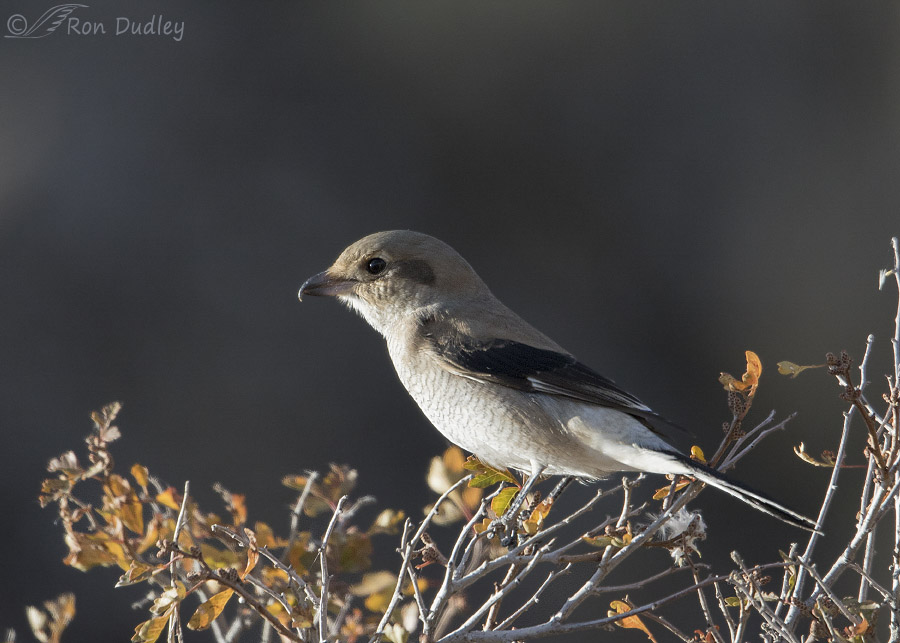
Yesterday morning in northern Utah I photographed my first Northern Shrike in a very long time. This is only a documentary shot because the bird was strongly and horribly sidelit but I was still happy to get it. This individual is a juvenile as evidenced by its brown/red tones, scaled breast and paler bill. This bird must have been a recent arrival from the north country.
In the 10+ years I’ve been photographing birds I’ve only seen a handful of Northern Shrikes.
Loggerhead Shrikes are common in Utah and are here year around (I photograph them often) but the tundra-breeding Northern Shrike only visits Utah in winter and is much less common.
The Northern Shrike is larger and has a more strongly hooked bill than its southern cousin and that allows it to take larger prey on average. Northerns regularly feed on mammals and birds and those birds include some species significantly larger than themselves, including robins, jays and doves. Soon after this photo was taken this bird flew past me with a small bird in its clutches. They truly are “wannabe raptors”.
I often make the claim that I’m more of a bird photographer than a birder but sightings like this do bring out the birder in me.
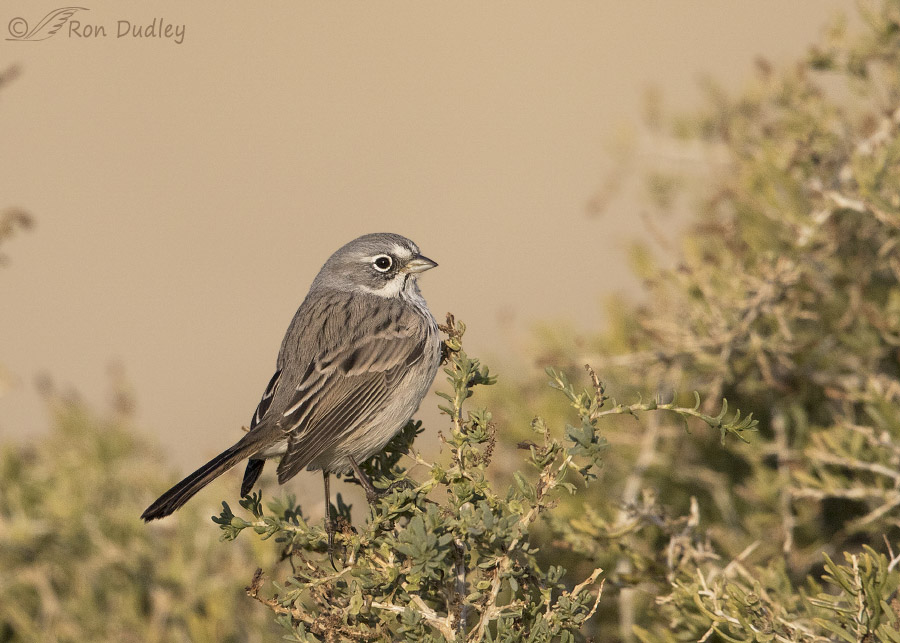
Another species I seldom photograph or even see is the handsome Sagebrush Sparrow but I spent some time with this bird six days ago on Antelope Island (the following photos are all of the same bird). For years the Sagebrush Sparrow and the Bell’s Sparrow were known collectively as the Sage Sparrow but the American Ornithologist’s Union split them into two species in 2013.

The poor little sparrow was extremely tolerant of my presence but a gang of mostly juvenile White-crowned Sparrows was harassing it mercilessly so it did its share of cowering. You’ll soon see evidence of why this bird was so wary.
It did come out in the open a few times which provided a better look at some of its markings including those two white forehead spots and complete white eye-ring.
When it turned on the branch I got a good look at the entire bird. The sparrow was quite relaxed on this elevated and exposed perch but it shouldn’t have been because..
it was soon aggressively attacked by a juvenile White-crowned (almost twice its size, 1 oz. as opposed to .58 oz.) and displaced from the branch. Here the blurry bird in the background is the Sagebrush Sparrow fleeing from its aggressor.
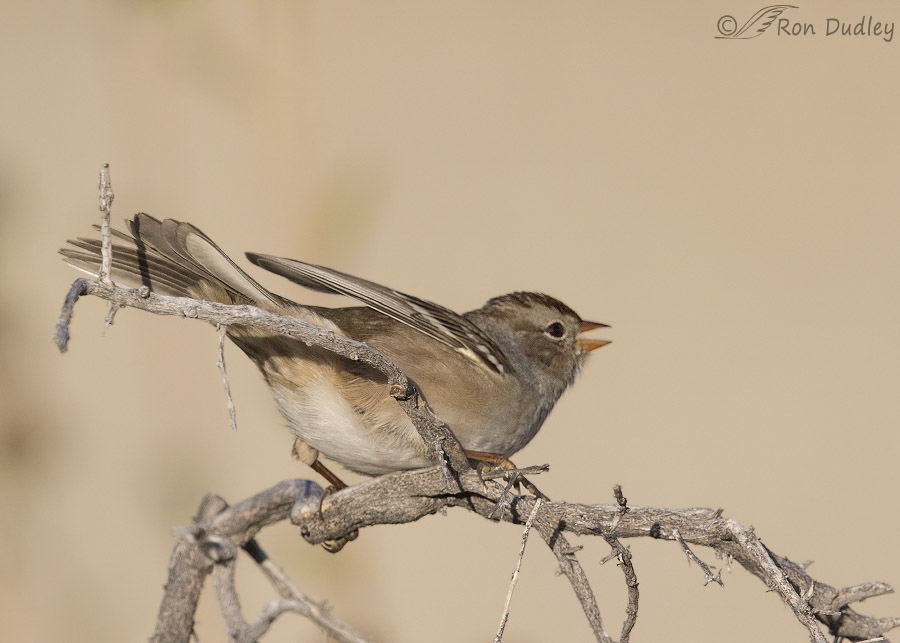
The White-crowned made its nasty attitude obvious.
After photographing birds for as long as I have I don’t see species that are unusual for me very often anymore so these two sightings were a lot of fun. Perhaps I’m more of a birder than I think I am…
Ron
PS – Apologies for not including image techs but I simply ran out of time.


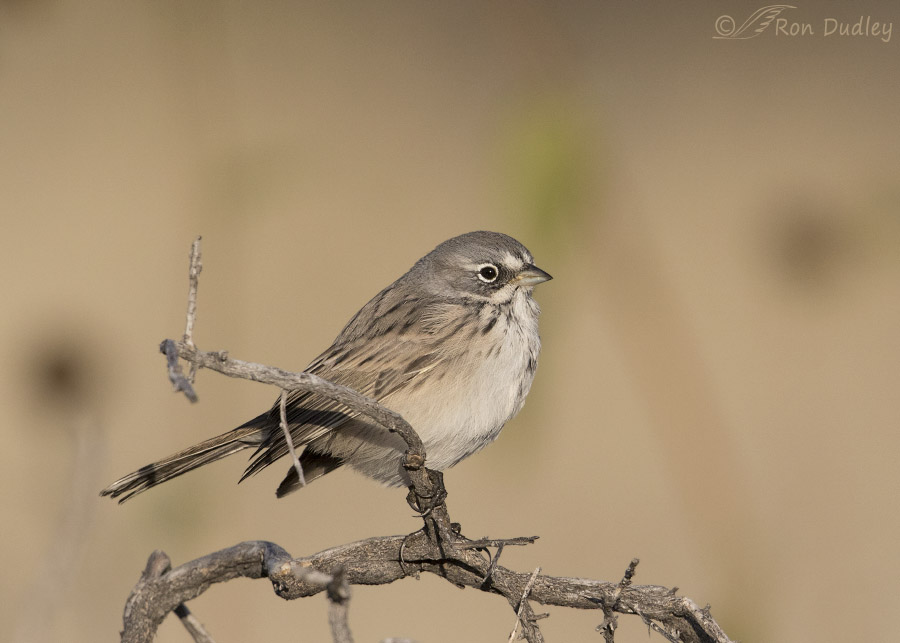
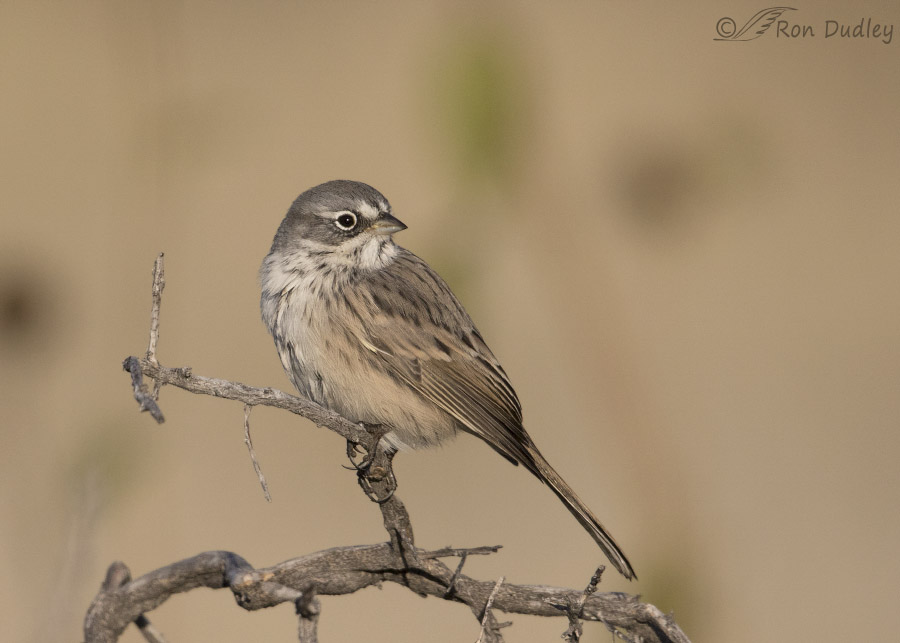
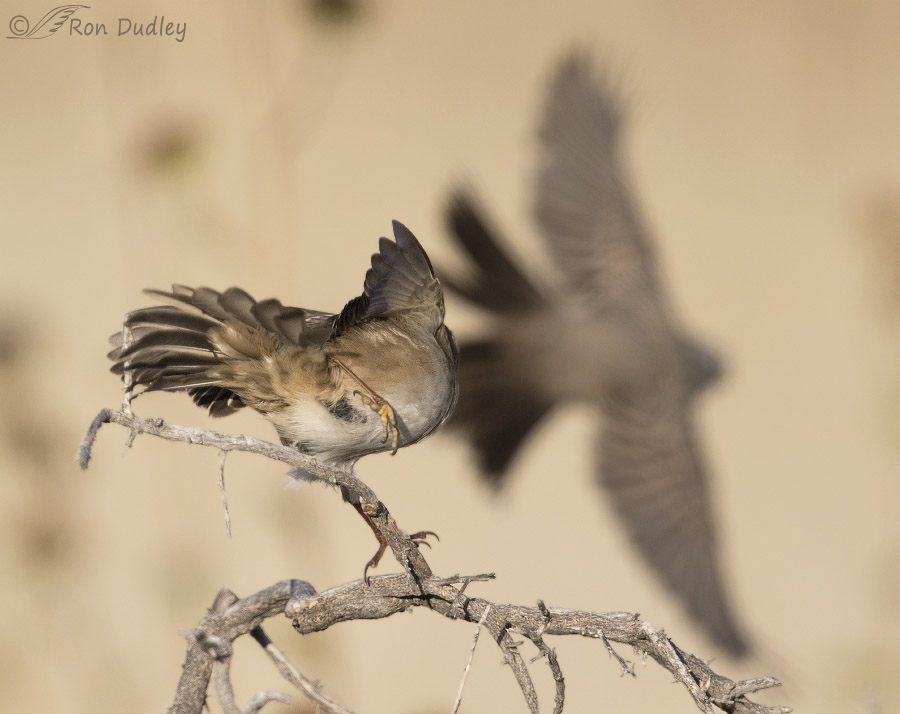
Of course you are a bit of a birder. Our obsessions consume and change us.
Loved seeing the young pint-sized assassin. And have a huge weakness for sparrows. And have often noticed that ours are surprisingly aggressive, often it seems just because…
Yup, “just because” is all the reason they often need, EC!
Ron, a very interesting series. I like the background in the first photo because it really enhances the colors in the bird.
As for this poor little sparrow, I felt sorry for it. We have many scrub oak trees in our back yard and a bird feeder. I see different species of birds in the trees and feeder [wish I knew what kind they are] either playing or fighting with each other. I can’t tell but love watching them.
Thanks for the teaching moment, Ron.
Alice, That very dark background was the shaded portion of a small cliff. Thank you.
Great shots Ron, you are fortunate to live in an area where you can see both species of Shrikes. We see Northerns here in the winter, but rarely. I got my life Loggerhead in North Dakota.
When we went out west before they changed the Sage Sparrow to two species, got the coastal variety, A. belli in CA, a good looking sparrow.
Do you think the White-crowned was just showing dominance or protecting a food source?
Probably just demonstrating dominance, Dick. Sunflower seeds were in abundance almost everywhere you looked.
Some of those LBJs can be the nastiest when they really want something. We have a ton of them at the shelter (“helping” the dogs to eat their kibble). There have been some knock-down-drag-outs over a single morsel despite a full bowl right next to them. I guess the White-Crowned wanted to be “king of the hill.”
I also really like the shot of the shrike. The intense sidelight definitely provides the context of you being out there at 0-dark-30. Beautiful!
I don’t dislike that shrike shot, Marty. But I had to do more processing on it than I like to in order to make it look presentable.
Wonderful series Ron! Always great to find unusual birds!
Charlotte
Thank you, Charlotte.
A nice series of an interesting variety of birds to start the day with…didn’t know white crowned sparrows were so aggressive…the sagebrush soarrows are so cute.
Patty, usually I don’t see this much aggression from White-crowned but for some reason they sure didn’t want the Sagebrush Sparrow hanging around. It wasn’t like there weren’t plenty of sunflower seeds to go around…
For the record, I quite like the ‘strong and horribly sidelit’ photo of the Northern Shrike, and am delighted with the photo with the blurry Sagebrush Sparrow.
I love the science and the professionalism of your photos, and I also love the drama of many of those that don’t pass professional muster. Thanks for sharing these as well, when you decide they’re worth including, Ron.
I often enjoy some of my photos that don’t “pass professional muster” too, Alison. That’s pretty much a requirement if you’re as interested in behaviors as I am.
Ron, as you say, its always fun to see birds that are unusual for you. I may not get out as much as you, but got somoe shots of a loggerhead the other day that was a first for me, and that was special, for me. Number 4 of the sage sparrow is my favorite, good head angle, goof light, nicely framed. Thanks again.
#4 is my favorite too, Frank – for the reasons you mentioned
As far as I know we only have Loggerhead Shrikes here. I’ve seen one on a couple of occasions, but have never had the privilege of seeing any of their interesting behavior, or evidence thereof. The Sage Sparrow is a gorgeous bird, LBJ or not. It’s definitely exciting seeing new species. I saw my first-ever Pied-billed Grebe yesterday and my first Ruddy Duck. I don’t think that makes any of us a birder (or a whatever – I get excited over new species of grasshoppers, bugs, etc.). I think it’s more about the discovery of something unfamiliar and becoming more in touch with the world around us.
Susan, one can usually find shrike prey (grasshoppers, other large insects, small birds and even mammals) impaled on barbed wire or thorns if shrikes are around. Sometimes it can take some serious looking in their territory before you find them though. Often those caches are hidden in brush.
Glad you captured both species, Ron. We occasionally have the Loggerhead and boy do they clear the feeder! The sagebrush sparrow is certainly a cute LBJ:) I’ve never thought of sparrows as being particularly aggressive – “wrong”. You really captured that moment!
I’d have guessed that you would see more Northern Shrikes than I would, Judy. But then they’re not common anywhere in their range and you have to get a fairly good look at them to distinguish them from Loggerheads.